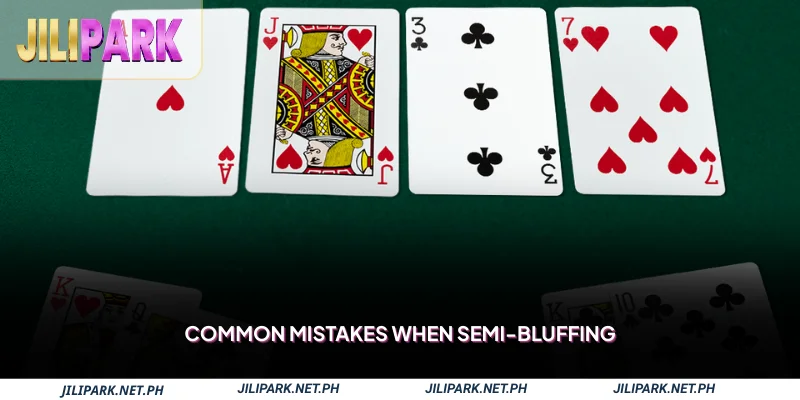Most poker players looking to better their game would benefit from knowing some Semi-Bluff Tips. Unlike pure bluffs, semi-bluffs involve betting with a hand that isn’t strong yet but has a lot of potential to get better. This approach is a perfect mixture of aggression and math, and is thus very effective in both cash games and tournaments.
What Is Semi-Bluffing and Why It Works
The term “semi-bluffing” refers to a strategy that mixes elements of bluffing and value betting. As an example, a pure bluff is betting with no winning chances unless the opponent folds. As for semi-bluff, it is betting with a drawing hand that has a possibility of making the best hand by the river. This strategy is effective as it creates some leverage on the opponents and, at the same time, maintains some value in the pot.
The concept of bluffing vs semi-bluffing
Where there is a high-reward poker move, such as a “pure bluff,” it also comes with high risk. A “pure bluff” is when one represents strength without a real hand. A semi-bluff is when one has two outs because your opponent can either fold or you complete your draw and win at the showdown.
Semi-bluffs are beneficial for a larger pool of players even when called. Unlike pure bluffs, semi-bluffs can still be effective even against tighter opponents who play fewer hands, because you either win when they fold or improve your hand if called.
Mathematical value of semi-bluff in Poker
The effectiveness of semi-bluffing is rooted in its mathematical intricacies. Let’s look at it closely:
- Fold Equity: The likelihood of your opponent leaning toward folding due to your wager.
- Pot Equity: Your statistical winning share of the pot if the game advances to a showdown.
In a semi-bluff, both are factored in. Assuming you are working with a 30% chance to win the hand, and a 40% chance of your opponent folding, your total equity is 58% (30% equity + 28% equity due to your opponent folding).
The table below summarizes, but we will continue to complexify it.
| Scenario | Probability | Contribution to EV |
| Opponent folds | 40% | 40% of the pot |
| You hit your draw | 30% | 30% of the pot |
| You miss & lose | 30% | 0% |
This shows how each scenario affects your overall profitability in the long run.
Key difference: having outs to improve
A defining feature of a semi-bluff is “outs”, or cards that can improve your hand. A pure bluff has no outs; a semi-bluff has a minimum of eight outs, like open-ended straight draws or flush draws.
An example is having 7♥ 8♥ while a 6♥ 9♣ K♦ board is showing. You have an open-ended straight draw, and even if your opponent calls, you have eight outs to win (4 of the 5s and 4 of the 10s).
This safety net helps lower the risk and increase profitability, especially with deep stacks where the implied odds have more value.
Criteria for Making a Smart Semi-Bluff Tips
Every semi-bluff is different. Profitability is different as well; consider the board texture, the player you are playing with, and even the size of each player’s chips before placing your bet.

Board texture and your equity
A semi-bluff is more effective on coordinated boards like J♠ T♠ 5♥ since they have more possible straight and flush draws. On dry boards like K♦ 7♣ 2♥, semi-bluffing becomes more dangerous because of a lack of draws.
Your equity changes based on the number of outs. A flush draw is a stronger draw than a gutshot because it has more outs. Flush draws are 9 outs, gutshots 4. Always evaluate aggression vs the strength of the draw.
Opponent tendencies and table image
Versus a nit who folds far too often, semi-bluffing becomes a profit-generating marvel. However, with a calling station, value betting is far more purposeful.
Your table image is important too. If you have been caught bluffing recently, opponents may go out of their way to call you down. Adjust by switching to more value-oriented betting schemes or tightening up some hands.
Stack size and position at the table
Short stacks have to be cautious when semi-bluffing (risk of getting priced out). More aggression is possible for deep stacks because of implied odds.
Position is critical; semi-bluffing from late position gives you more control over the hand. Do not inflate the pot out of position unless you have a strong draw.
When to Semi-Bluff – Timing Is Everything
Great players set themselves apart from good players with timing mastery. In semi-bluffs, both fold equity and pot equity must align for the specific situations where they will work best.
On the flop with straight or flush draws
The flop is prime time for semi-bluffing. Your equity is highest when you still have two cards to come. For instance, raising on the flop with a flush draw puts pressure on your opponents right away and allows for profitable turn barrels later if necessary.
Turn and river spots – risk and reward
By the turn, your equity shifts significantly. There is room for a delayed semi-bluff when your hand improves slightly, such as picking up additional outs through a backdoor draw — for example, hitting a second suited card that creates a potential flush draw. River semi-bluffing is rare, other than instances where a bluff catcher or blocker has been picked up.
Avoiding overbluffing in tight games
In close matches, opponents optimize by folding more often, so unopposed bluffs may get through. Over-semi-bluffing can lead to adjustments that exploit you. Keep your balanced approach to your range to avoid being predictable.
Common Mistakes When Semi-Bluffing
Even expert players make mistakes when semi-bluffing. Understanding these mistakes can help save you cash.

Bluffing into calling stations
No matter how persuasive your bet is, calling stations will not fold. Only use semi-bluffs on opponents who can fold.
Misreading your equity or pot odds
A surefire way to lose money is placing bets without knowing your outs or pot odds. You must always ask yourself if the risk is worth the reward.
Repeating patterns that become readable
Avoid developing predictable patterns, such as only semi-bluffing with flush draws. Skilled opponents will recognize and exploit these habits.
Expert Semi-Bluff Tips from Pro Poker Players
Advanced techniques, such as balancing ranges around blockers, further assist pros in maximizing the profitability of semi-bluffing.
Balancing your bluffing range
A well-structured strategy comprises both bluffs and value bets. For example, if you would bet top pair here, sprinkle in some semi-bluffs to be unexploitable.
Using blockers effectively
Blockers increase the chances that a player can profit from a hand they could potentially lose. Having A♠ while the board displays several spades makes it more unlikely that your opponent holds the nut flush draw.
Mixing in check-raises with draws
Check-raising with draws disguises your true hand strength while adding value to the pot for the times you connect. It’s an advanced technique that capitalizes on overly aggressive players.
Conclusion
One of the most underutilized strategies in poker is semi-bluffing. With perfect execution, it can turn losing hands into winning plays. Understand the smart semi-bluffing strategies today, and watch the numbers in your winning percentage increase.

